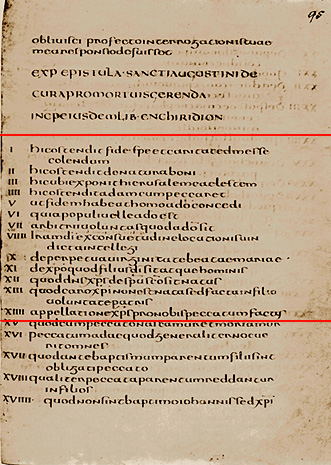
The beginning of our ‘lower case’ scripts, though it would not have meant this to the original writers. The name used for this type of script is minuscule, ‘slightly smaller’, as opposed to the ‘somewhat larger’ majuscule.
It was current at the same time as Roman Uncial, and a cursive version was used for rapid correspondence and note-taking. It was immensely influential, and was used all over Latin Europe: later versions developed into both the strikingly formal Insular Half-Uncial, otherwise known as Insular Majuscule, and the elegantly practical Carolingian Minuscule, as well as the various Anglo-Saxon vernacular scripts.
Bamberg Staatsbibliothek MS Patr. 87 contains the works of St Jerome and St Augustine. It was written in Italy in the 6th century A.D.
This page, folio 95r, contains the chapter headings for Augustine’s Enchiridion (‘Handbook’) on theological matters.

| |
| |
| |
|
|
| |
| |
| |
| |
| |
| |
Return to Index.
© MEG TWYCROSS 1998